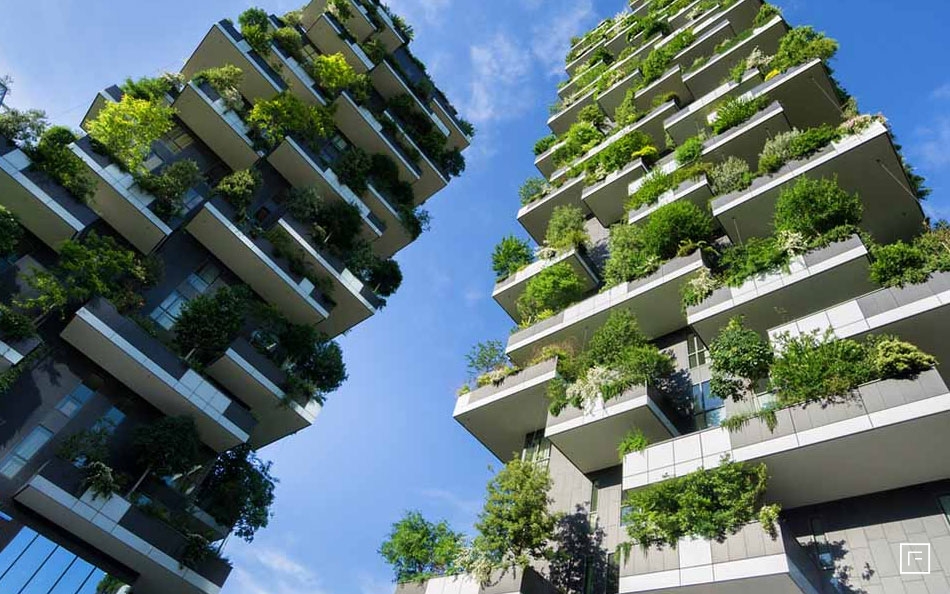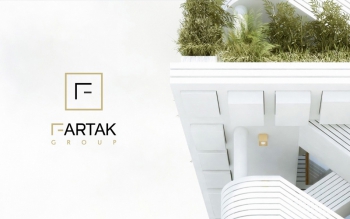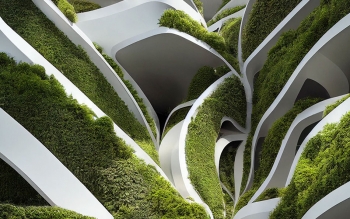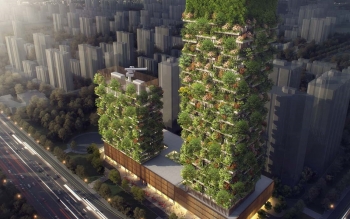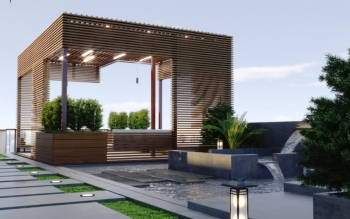Green Architecture in Iran:
Today, sustainable architecture, the way of architectural design that is based on environmental aspects, is a special thing.
This style of design, which architects and designers try to pay more attention to, and the architects of Iran, as a vast country with different climatic regions, had to use for so long time [even] in traditional architecture of Iran.
Our world seeks to minimize negative environmental impacts. In the past, architects have been obliged to rely on natural sources of energy to make the internal conditions of buildings pleasant in order to increase the efficiency and create balance between use of materials, consumption of energy, and development of the [living] space as they had no access to modern heating and cooling systems.
Iran is basically divided into four climate zones:
- Zone one; a hot and dry zone which mostly includes the Iranian plateau.
- Region two; a cold and snowy region in the north and west of the country.
- The third; the hot and humid region that includes the northern coasts of the Persian Gulf and the Persian Gulf.
- Oman Sea and the last and fourth region; the humid and rainy area that covers the southern coast.
Iran and Energy Sources:
Iran has huge reserves of oil and natural gas and is one of the most important centers of energy and resources in the world. But due to its widespread use at the current rate, it will be difficult to store and export it. In the next few years, all oil resources will face shortage not only in Iran, but all over the world. Therefore, new sources of energy and proper solutions to reduce consumption of oil and reserving it should be studied and investigated. Creating a clean world and thinking about returning to nature, as well as restoring the chaotic relationship between man and nature to a balance, are issues that has been long a concern to Iranians and their tradition, and Iranian architects have been among the pioneers of this movement.
Today, we bring comfort to our places by using expensive energy sources.
The use of renewable energy sources such as solar, wind, heat and water energy is effective in decrease of costs that are incurred as a result of using and depreciation of mechanical equipment.
In traditional Iran, due to the cold of winter and hot and humid of the summer in some areas, designers and architects have been forced to employ and provide environmental elements. For instance, in hot and dry areas where there is no rain for at least 6 months of the year, the cooling process is one of the important goals in designing a plan.
Hot and Dry Areas
Iranian traditional architects have tried to use heat transfer and evaporation, and for this reason, environmental elements such as water and wind have played important roles in their designs. For the very same purpose, sustainable systems and equipment such as windbreakers (wind catcher or wind tower) or designs similar to special rooms in the traditional houses in which there was a small pool and it was equipped with wind towers to ventilate the air during the hot weather (Hoz-khaneh) are among the registered designs by valuable Iranian architects. As sustainable architecture in Iran suggests various solutions that are compatible with the environment, therefore, potential reserves in natural ventilation play an essential role as a certain parameter for cooling and feeling comfortable. A wind catcher or wind tower, which is included as a wind breaking system in the design of architects, works according to the conditions of the wind and sunlight in relating areas. It adjusts the circulation of the wind in different places of a building using the force of the wind that flows through the precisely designed holes on its structure and by opening and closing of the channels carefully placed in various parts of it. The internal and external walls of it absorb a lot of hot temperature during the day, and by giving the absorbed heat to the cold air of the night, it will create a balance by increase in the temperature at night. The dimensions of the holes inside the wind tower are designed in such a way that it keeps enough heat. Light warm air rises inside the windbreaker and is sucked in by the high altitudes. As a result, cool air flows into the house from the windows and doors and that flow continues throughout the night.

With this system, the building uses natural energy without using expensive resources, which works like modern cooling devices of today to keep the building cool. In the hot and dry zone, there is an area called "Pool House" (Hoz-Khaneh) inside the buildings. There is a pool full of water in this space and the wind that is guided through the holes of the wind tower by special channels reaches this place and in fact the wind uses the water and evaporation takes place, which leads to the cooling of the atmosphere and that creates the “Summer House" which is a place to live in hot and dry summers.

Cold and Snowy Region of North and West of Iran
This region, which is also known as the mountainous region, includes the northern and western regions of Iran. The cold and snowy weather reduces public activities in the very cold and long winter seasons. Therefore, the goal of sustainable design in this area is to create a warm atmosphere and all systems are based on that purpose. Just as the wind and water played the main role in hot and dry regions, the sun and solar energy also play the main role in the cold regions.
In these areas, an attempt is made to use more solar energy and to achieve that, the height of main parts of the buildings are designed towards the south in order to enjoy more of the sun light. Moreover, the windows of these high places of a structure are chosen to be larger in order to receive more sunlight, and the materials of the walls are such that they can retain more heat.
In these areas, where it snows often, traditional architects and designers have come up with a special place called the refrigerator, which is meant to keep water in solid form of ice and also to keep it cool in the summer season. The dome-shaped structure of the refrigerators makes its internal air temperature always cool and it is used a lot for having cool water available during the summer.

Hot and Humid Area
Northern areas of the Persian Gulf and Oman Sea These areas are very hot and dry especially during the spring and summer due to being close to the sea shores. In hot and dry areas, the basic and important point in the design is to cool the space, but in these areas, humidity should also be taken into consideration. Shading and air conditioning are two significant parameters that are considered in the sustainable design of buildings in these areas. Porches and balconies and also Kapar (small huts made usually of Tamarisk and palm trees), are some sustainable systems designed for buildings in hot and humid areas.

In the architecture of hot and humid areas of Iran, architects have considered all aspects and problems of climate change. The height of the building has always been one of the subjects to be examined. The most important room in the building, which should be the coolest room, was designed in such a way that it is located at the highest point of the building and in its construction, materials and colors that reflect sunlight and keep the room cool are used. The porch is also located at the highest point of the building that receives more wind and can be used as a preventing layer in the main structure of a building to keep it farther from direct sunlight, which leads to the creation of shade and cool air in the building. Kapar, also known as the straw hut, is a temporary structure made of straw and mostly used in rural areas in which certain sustainable systems used to create cool shade inside the hut and also prevents the heated air from remaining stale. Due to the structure of the body of a Kapar that is made of straw, the air conditioning operation is done easily and well.

Wet and Rainy Areas; the Southern Coasts of the Caspian Sea
In these areas, which benefit from the shores of the Caspian Sea, the annual rainfall is about two meters per year and the humidity also reaches 80% per year. Therefore, humidity plays an important role and since there is a lot of rainfall, the most important architectural parameter that is considered in the design of buildings in these areas is the roof of the building. Usually, the roof of these buildings is designed with a special slope to control rainwater and the materials used in the roof and body of the buildings are natural materials with local names such as Gali and Simka. Because of humidity in these areas, the porch/balcony of the buildings will cause cooling - air conditioning and also provides the favorable air for the building.

The Amount of Energy Consumption
Regarding the amount of energy consumption, even though all attention is drawn towards electric cars and the reduction of fossil fuel consumption by vehicles, it might surprise us to know the biggest consumer of energy is the buildings!

According to researches, generally 20.4% of the amount of energy consumed in the United States is related to residential buildings, which is a very considerable amount. The concept of green architecture is actually the philosophy of focusing on the design of buildings having the least negative aspects in the surrounding space, as well as the use of sustainable materials and energy sources in order to reduce energy consumption and update the existing buildings with new technologies. The sustainability of green buildings will lead to improvement of the quality and management of energy and its waste as well as water, land, resources, greenhouse gases, material, design, and facilities in a green building. Green architecture and buildings with green structures are unique and valuable mostly because of their high cost of construction with a green concept, which is generally much higher than ordinary and traditional structures. Perhaps the reputation of green architecture has reached us in recent years, but throughout history it has always been considered as an important matter for the survival of living beings. Green architecture is actually a favor to mankind by creating a more sustainable way to live on the planet. Ian McHarg, the founder of the architectural industry in landscaping, gave the first rules of green architecture in his book, Design with Nature. Green architecture can also go back to the ancient civilization that made life possible in different climates. Montezuma Castle, a remote desert rock dwelling located in Camp Verde, Arizona can be a prime example of such a thing. Green architecture and the effort made to expand this style of architecture in the area of modern urban development is rooted in green mindset and viewpoint towards all related subjects that will lead to expansion and development of green idea in the individual and social lives of the people the impact of which on quality and quantity of living condition as well as survival of living species on planet earth is truly significant.

Some of the advantages and disadvantages of green are briefly mentioned:
- The green building will make efficient use of water, heat and other energy sources.
- Green building helps manage renewable energy sources such as solar panels.
- Indoor air quality will be higher than general standards.
- In green building, non-toxic, pleasant and sustainable materials are used.
- The structure of the green building is evaluated based on building standards, and sometimes the result of the evaluation is slightly higher than the structures in which very unique and expensive materials have been used.
- Green architecture, however, maintains the value of arranged and orderly buildings by allocating amounts of funds for the purpose of maintenance, renovation, and at times demolition of the building. This does not mean that green buildings do not require to be maintained, renovated, and even which are made from energy sources, is rather useful and sustainable. The efficiency includes water, energy and material resources. Green building is not familiar with the concept of waste! Recovering rainwater and using it for toilet flushing and preventing water loss in these buildings save a lot of energy consumption compared to buildings made of bricks. They depend only on renewable sources of energy such as solar energy, hydroelectricity, and wind power which are used for heat and electricity and help improve indoor air quality.
- Green buildings are made of natural, non-toxic and recycled materials that do not cost much and are environment-friendly.
- Infrastructure maintenance: These buildings, which are both energy and water efficient, greatly expand the capacity of local infrastructure.
- High rate of return on capital: Considering that these buildings are completely natural, they have high investment returns and properties located in such buildings are sold at higher prices.
Some disadvantages of green buildings that we briefly mention herein:
- Location: Sincethese buildings depend on the sun for supply of energy, they must be positionedin a place that gets the best sunlight; something which may require them to belocated in front of other buildings in the neighborhood.
- Availability: It isdifficult to find materials to build such buildings, especially in urban areaswhere preserving the environment is not the priority in people's behavior andlifestyle. So transporting these materials can cost a lot more than a standardbuilding.
- Long Construction Period: Green buildings require more time to be designed and built.
- Construction cost: Currently,green buildings require higher cost for construction than conventionalbuildings because they depend on many natural materials that might not beavailable at all times and places.



